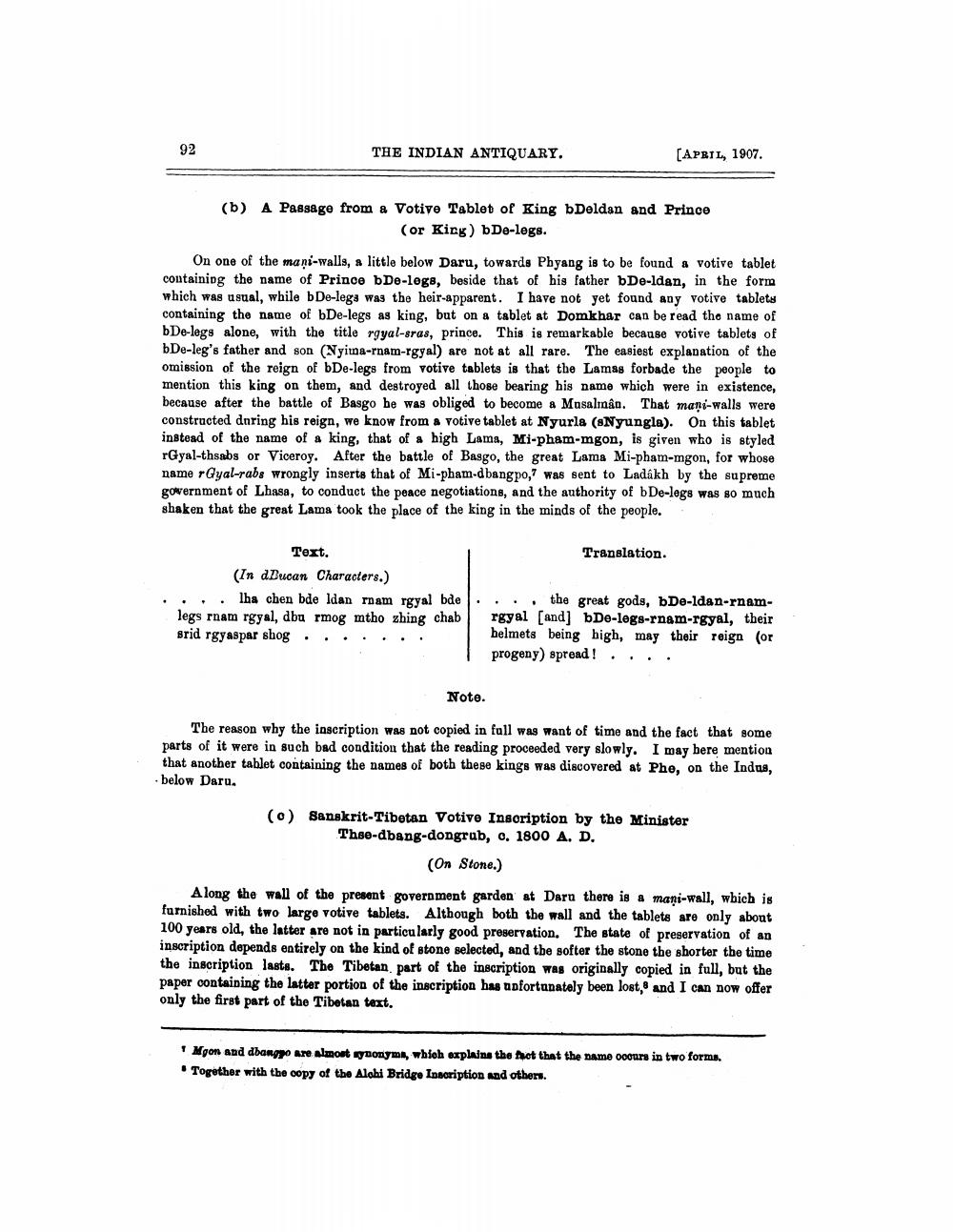________________
92
THE INDIAN ANTIQUARY.
[APRIL, 1907.
(b) A Passage from a Votive Tablet of King bDeldan and Prince
(or Kirg) bDe-legs.
On one of the mani-walls, a little below Daru, towards Phyang is to be found a votive tablet containing the name of Prince bDe-lege, beside that of his father bDe-ldan, in the form which was usual, while bDe-lega was the heir-apparent. I have not yet found any votive tablets containing the name of bDe-legs as king, but on a tablet at Domkhar can be read the name of bDe-legs alone, with the title rgyal-sras, prince. This is remarkable because votive tablets of bDe-leg's father and son Nyitna-rnam-rgyal) are not at all rare. The easiest explanation of the omission of the reign of bDe-legs from votive tablets is that the Lamas forbade the people to mention this king on them, and destroyed all those bearing his name which were in existence, because after the battle of Basgo he was obliged to become a Masalınân. That mani-walls were constructed dnring his reign, we know from a votive tablet at Nyurla (Nyungla). On this tablet instead of the name of a king, that of a high Lama, Mi-pham-mgon, is given who is styled rGyal-thsabs or Viceroy. After the battle of Basgo, the great Lama Mi-pham-mgon, for whose name Gyal-rabs wrongly inserts that of Mi-pham-dbangpo, was sent to Ladakh by the supreme government of Lhasa, to conduct the peace negotiations, and the authority of bDe-legs was so much shaken that the great Lama took the place of the king in the minds of the people.
Text.
Translation. (In d Ducan Characters.) ... lha chen bde ldan ram rgyal bde. ... the great gods, bDe-ldan-rnamlegs rnam rgyal, dbu rmog mtho zhing chab r gyal [and] bDo-legs-rnam-rgyal, their srid rgyaspar shog . . . . . .
helmets being high, may their reign (or progeny) spread! ....
Note.
The reason why the inscription was not copied in full was want of time and the fact that some parts of it were in such bad condition that the reading proceeded very slowly. I may bere mention that another tablet containing the names of both these kings was discovered at Phe, on the Indas, below Daru.
(0) Sanskrit Tibetan Votive Inscription by the Minister Thse-dbang-dongrab, c. 1800 A. D.
(On Stone.)
Along the wall of the present government garden at Daru there is a mani-wall, wbich is furnished with two large votive tablets. Although both the wall and the tablets are only about 100 years old, the latter are not in particularly good preservation. The state of preservation of an inscription depends entirely on the kind of stone selected, and the softer the stone the shorter the time the inscription lasts. The Tibetan, part of the inscription was originally copied in full, but the paper containing the latter portion of the inscription has unfortunately been lost, and I can now offer only the first part of the Tibetan text.
Mgon and dbangpo are almost gynonyms, which explains the fact that the name ooours in two forms. . Together with the copy of the Alohi Bridge Inscription and others.




